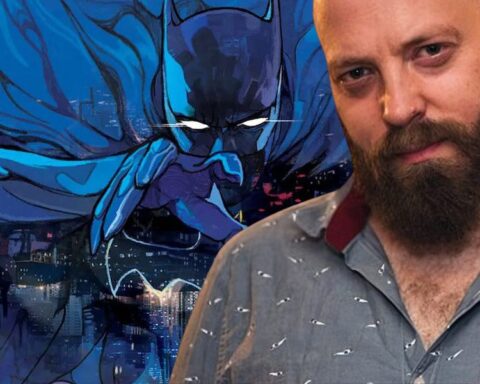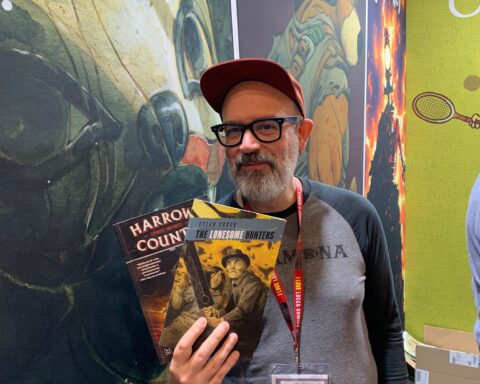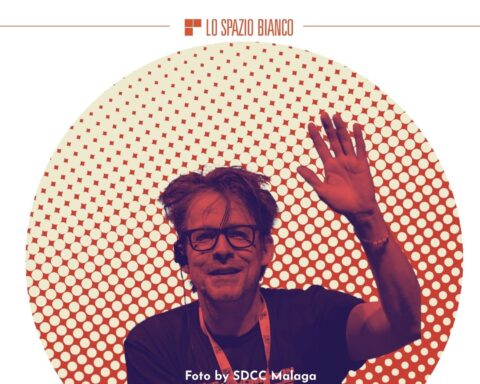For at least two decades, Scott Snyder has been one of the most prolific and important writers in the U.S. mainstream.
After his beginnings at Marvel, his consecration came in 2010 with American Vampire, a horror series made for Vertigo in which the author uses the horror imagery of vampires to reread American history. From there he made the leap into the world of superheroes, linking his name to that of Batman with so many series, from Detective Comics to the regular series together with Greg Capullo and on Batman Eternal during the New52 relaunch, and then writing various minis related to the character and no less than two events, Dark Nights:Metal and Dark Nights: Death Metal, which take their cues from various elements scattered throughout the character’s stories. After writing many superhero series for ten years (in addition to Batman, Swamp Thing, Justice League, and Superman to name a few), he decided to return to creator-owned in the 2000s: with Tony S. Daniel he launched a very successful kickstarter for the Nocterra series (later published by Image); for IDW he created the world of Dark Spaces where, in addition to writing two miniseries with Hayden Sherman, he also edited other miniseries; most importantly, he entered into an agreement with Comixology to produce, under his Brett Jackett Press imprint, a number of titles together with major artists with whom he had collaborated in the past. Four series (Night of the Ghoul with Francesco Francavilla, Branstormers with Tula Lotay, Clear with Francis Manapul, and We Have Demons with Greg Capullo) ranging from adventure horror to more atmospheric horror, passing through a love and action story and a sci-fi dystopia, each realized with different style and narrative registers and a first-rate artistic compartment, presented in Lucca by Star Comics in beautiful hardback editions.
We spoke with the author about these stories, his relationship with narrative genres and how they allow for deep but not pedantic reflections, but also about his work in creator-owned and mainstream superheroics, also in light of DC Comics’ recent launch of the Absolute Universe, in which Snyder is an absolute protagonist with his Absolute Batman.

You have created many horror stories in your career, from American Vampire to the ones you created with your imprint in collaboration with Comixology and that you are presenting in Lucca with Star Comics. Where did the love for the genre come from and why do you think it is so interesting?
It began when I was 9 or 10 years old. I was a very nervous kid, had a lot of anxiety, a lot of fears. And for some reason, I just fell in love with watching horror movies because, and I didn’t understand it at that time, they gave me a place to go experience those fears in a safe way. Therefore horror became a way for me to work through a lot of my worries.
Then, when I started writing, I just gravitated towards horror because it felt like the things that kept me up at night, the things that I really was afraid of, I could deal with when I wrote about them. When I had a lot of trouble with them, or reading about them might be too much for me sometimes, but writing about them, I could explore them on my own terms.
Ever since I can remember, horror has been my favorite genre. Stephen King was my favorite writer growing up, the first movie I loved was Night of the Living Dead, I had a subscription to Fangoria and Cinefax and all those special effects magazines and everything.
You also used horror to explore American history, like in American Vampire, and then you went further in this exploration with Undiscovered Country, foreseeing a dystopian reality. So, what’s your interest in exploring this thing with genre comics? Whatàs the power of genre comics in telling story like these?
I feel that genre is always a delivery system for powerful messages about the moment we are living in. If you think about when a genre arise,these are often stories that wind up channeling a lot of the emotion of the time in which they were born. Take the noir, for example: it comes about in the aftermath of World War I and the lead-up to World War II, and it reflect the anxiety around conspiracy, around the problems of big cities; or horror, that really springs up in the movies in the 30s and 40s and reflects the anxiety of the time, the Great Depression and then the war. Or also western, that are all about how do we see ourselves as Americans: they’re not written during that period of time, they’re written now as a mythology about who Americans are. Let’s think about some of the best genre move, like Chinatown, that convey that 60s of values falling apart, or if you think even to Blade runner, they are all works that are speaking to that moment through genre, identifying or analyzing who we are as people at that moment
So, to my mind, genre has always been a way of exploring the American character as an identity. For me looking at American history and sort of American values through the lenses of genre has always been the thing that I love to do, whether it’s science fiction, as in Clear, for example, or it’s adventure like Undiscovered Country or horror like American Vampire or a western noir like Canary. All of these stories it’s me trying to examine the moment and the things you’re excited about, afraid of, about who you are as a person and who you are as a country in that given time. So, genre has always been a way of exploring that..

During your career you wrote (and you’re writing) for DC Comics, but you’re also doing a lot of creator owned series, you also founded your imprint, working first in digital with Comixology and then also printing it with Dark Horse (and in Italy with Star Comics).
What was the idea behind to start and doing an imprint? And why starting with Comixology?
When I was at DC at the time and my contract came up, I argued to get an exception to my DC work to do creator-owned at other companies. They were supportive in this, but I never had time to write anything because I was so consumed with Batman and The Dark nights: Metal and follow up events. In 2020 it felt like I really wanted to leave and sort of commit myself to doing creator-owned for a few years. And it felt like if I started an imprint, then I would set a level of commitment to making a number of books that I would have to produce, whether I did them or I did them co-writing with other people, or I did books where I was fostering other people, like I did at IDW with the Dark Spaces line with Shane Grayson and Jeremy Lambert. Whatever it was, it would be a commitment to creator-owned under this umbrella for at least a few years. It made me feel like I had to put my money where my mouth was and really make books. I looked for different publishers that wanted to be a part of it: IDW was very supportive about doing some books there with Dark Spaces, Image was supportive doing first Undiscovered country and then a long ongoing series like Nocterra. About that time, Comixology came in and said, we actually want to do a subscription service, we’re expanding and want to boost it, so if you want to do a number of the books with us, we’ll finance them, let you keep the rights with your co-creators. The deal was to have them all digitally for one subscription price, and then they can come out as printed version for Dark Horse. Each one of these places gave me something I believe in.
At IDW, doing Dark Spaces, I get to use this imprint to bring in new talent to the industry. Shea Grayson writing Good Deeds, Jeremy Lambert writing Hollywood Special, it was me helping a new writer and artist put a book together under Best Jackett Press. As I love doing big bombastic series, ongoings like American Vampire, I got the opportunity to do that again at Image. And then with Comixology, I really do believe very deeply that there should be a big digital browsable platform where especially kids and young people can find comics for cheap, browse them the way they do with manga and webtoons, but also tv series and movies. My hope was that Comixology would really be that base where we can make books, encourage people to get a subscription, browse all these great comics that they had from Dark Knight Returns to newer comics under their umbrella. That project got complicated by Amazon acquisition, but it seems they are working to get it better. These were all different publishers that would commit to parts of the project that I believed in.
Let’s speak about the books you are presenting in Lucca, four books with great artists
(Night of the Ghoul with Francesco Francavilla, Branstormers with Tula Lotay, Clear with Francis Manapul, We Have Demons with Greg Capullo). I would ask you for a brief comment on the works you are presenting here, a feeling you got from writing these stories, and a comment on the artist you worked with.
I was simply so lucky to get a murderer’s row of great comic artists. The way that it worked was it wasn’t like I had an idea and then I went to the artist and said, let’s do this book. It was more about telling them that Comixology has made this deal with me to make books with them for a bit, and what I’d like to do is find co-creators who want to build something together from the ground up. Let’s take the case of Francis Manapul and Clear, for example I went to him, as we are good friends, and he told he would like to do sci-fi. This is how Clear was born, a book about a dystopia, about fears of things coming, which is really all about what things are we afraid of for our kids right now. We we sat at a cafe by my house, he stayed with me for a few days after New York Comic Con, and we were talking about how in America what we’re afraid of is this notion of the erosion of any objective truth, of any reality that everybody believes is actual. Instead, people have more and more sort of belief in conspiracy theories, and in whatever thing enforces their pre-existing world belief. They just want more of that, as opposed to being challenged by different opinions, things outside their world of beliefs. And all these algorithms, whether it’s music like Spotify or Google, are just giving you more of what you already like when you look things up, as it knows your preferences. Talking about these things together we decided to make this futuristic story where the world has become a place where you can choose to see reality however you want, and everybody sees it in their own way, and nobody has an objective meeting point with each other. That’s where it came from. The fun of picking those artists wasn’t like, who will be right for my story? But rather viceversa.
Let’s take Barnstormers. I went to Lisa (Wood, the birth name of artist Tula Lotay, NdR), who’s also a friend, and I said: “Listen, you love the 1920s, I love the 1920s, let’s do something together”. I’ve always wanted to do something about kids flying planes then, because they’re daredevils. But I also feel that today we are living in a time similar to that one, 100 years later, where rich people were getting rich very fast with the stock market boom in the 20s, and states creating very bad labor laws.
Each of the projects was very much like a collaborative process from the very beginning all the way to the end, a product of a team, and that’s why I picked those people, those friends, because they were excited to do that together. And we had the rights, 50-50 on everything, like on the rights to the project, on the payments, on everything.
You spoke about Barnstormers and Tula Lotay, who was supposed to be a guest but unfortunately is not here. This comic is a little bit different for both you and her in regards to what you did before, a couple of issues on American Vampire, for example: there is a bit of romance, a bit of adventure. What can you say about this work?
It was definitely something different, a book with no supernatural elements, no monsters, she also never did a long six-issue sequential series either. But this was the whole idea of the imprint: let’s challenge each other to try things that we haven’t tried before!

How does your job change between doing your creator-owned work and when you are dealing with characters from another publisher, such as DC Comics?
They’re complete opposites world. When you work in a publisher like Marvel or DC, you come in and everybody already loves the characters, they love the city, Gotham if you take Batman, they know everything, and so you’re just trying to convince the readers that you have something to say. With creator-owned, readers don’t know anything about it, you know it and they don’t, and you’re coming in and they’re there because they believe you have something to say, but they don’t believe in the world or the characters yet, so you’re convincing them that this mythology, this set of characters, this cast is as exciting as the ones they know in superhero comics, but that it’s worth buying into. So it’s almost total mirror images.

Since you are talking about Batman, your name is really bonded to the characters, you’re one of the most important writers in recent years, so what was your take on the character when you started and what is your take now that you are back writing Absolute Batman? How was your return on this character in this new version?
It was really scary. I didn’t think I was going to do it at all until the last minute.
It was James Tynion VI that convinced me to do it. He was like: “You have this idea you keep talking about, you should just do it”. The difference when I wrote Batman with Greg Capullo, it was very much like me writing Batman as a proxy to us for fears that we had for the world and about ourself, trying to be brave and face them. After stepping away from it for a while, I had the opportunity to think about the Absolute line. The ethos of that universe is that these heroes are stripped down to their core and then rebuilt in a way that would be even more exciting now than they would be in the main line for young readers today. Not that the main line isn’t crazy exciting, but here the question was how do you take apart Batman and put him back together so that he feels even more dangerous, wild and resonant. So instead of writing Batman as myself, I would write Batman as someone inspired by my kids, inspired by the young generation I see out there that I feel like refuses to accept the world the way it is.
They have all of these kind of entrenched systems, political systems, economic systems that seem to just be collapsing , and they demand for something better than this. They protest against it. So I asked myself what if Batman was this young idealist and came up with nothing, a working class hero against villains that have all the resources? They are the system, while Batman is chaos. He’s not exactly anarchy, he doesn’t want everything to burn, but he is a kind of force of nature that believes it is necessary to break something to rebuilt it better. And he became bigger and scarier in that way, as a beast, a primal force. And in this story, the point of view that I relate to in it is Alfred, I’m the older generation watching the whole world being corrupted, while Batman is the younger who does not accept it, who want it to work in a better way, with a new approach, no matter what.
Inteview done at Lucca Comics and Games 2024 on November 2nd
Scott Snyder
Scott Snyder is an American author. He is known for his 2006 short story collection Voodoo Heart, and his work for DC Comics, including series such as American Vampire, Detective Comics, a highly acclaimed run on Batman, Swamp Thing, and Justice League as well as the company-wide crossover storylines “Dark Nights: Metal” and “Dark Nights: Death Metal.”, as well as the newest seriers Absolute Batman He has also written creator-owned comics published through Image Comics, including Wytches, Undiscovered Country, and Nocterra, and Dark Horse/Comixology.
Snyder has garnered critical acclaim from critics and fans for work, such his run on the New 52 version of Batman that debuted in 2011, and has won numerous industry awards, inclduing two Eisner Awards, a Harvey Award, and a 2012 Eagle Award for Best Writer.







